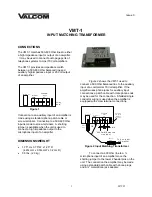
5.5
OPERATING MODES
5.5.1
RECEIVE
Carrier Detect and Squelch Operation
The DTX is a transceiver; i.e. it can receive and transmit, although not at the same time. A carrier
detect system exists within the unit to detect the presence of a carrier which controls the logic
state of the DCD (data carrier detect) output. The RF levels at which this output changes state
are programmable. In addition, the unit may be programmed such that the audio outputs, AUDIO
OUT and AUX OUT, are muted (squelched) in conjunction with DCD operation. In units where
squelch operation has been enabled, the RX MON input can be used to override a squelched
condition. The DCD output is not affected by the RX MON operation.
Receiver Audio Outputs
Two receiver audio outputs are present on the DTX module. The AUX OUT is a general purpose
output which can have pre-emphasis enabled or bypassed. Its gain can be controlled and its
output is designed to drive 1000 ohm or higher loads. The coupling from the discriminator on the
RF board may be set to AC or DC by the programmer. DC coupling allows for internal bandwidth
to extend to DC, but if a high gain value is chosen for the AUX OUT, clipping may occur on the
waveform due to discriminator voltage offsets. AC coupling removes this issue. The output stage
is AC coupled, but can be modified for DC coupling. This requires replacing a coupling capacitor
with a zero-ohm resistor. Contact Ritron for details on this modification. The AUDIO OUT is
always de-emphasized, but its gain can be programmed. This output can drive 8-ohm speaker-
type loads. In the programmer menu, there is provision to set both the AUX OUT levels and the
AUDIO OUT levels. However, the AUDIO OUT level is dependent upon the AUX OUT level.
Therefore, the AUX OUT level should be set before setting the AUDIO OUT level.
5.5.2
TRANSMIT
PTT Operation
The transmitter is activated by placing the PTT/RTS (Push-To-Talk/Request-To-Send) input in its
asserted state. This state is programmable. If the unit is to operate in simplex (transmitter and
receiver on the same frequency), one should check for activity on the channel before transmitting.
This can be done by checking the state of the DCD output. In addition, the unit can be
programmed so that transmit operation is inhibited if the DCD threshold has been exceeded
(busy channel lockout option).
CTS Output
The CTS (Clear To Send) output goes to its active state when the unit has powered up the
transmitter, it is locked on the correct transmit frequency, and it is ready to accept modulation.
This output may be used to signal a modem to start transmitting data. If this output is not used, to
avoid losing data, a delay of at least 12 ms is required between PTT/RTS activation and the
application of data.
Transmitter Audio Inputs
Two mutually exclusive audio inputs are available on the DTX module. The AUX IN is a general-
purpose input with an input impedance greater than 50 k-ohms and is capacitive coupled with a
lower roll-off frequency of about 25 Hz. The MIC IN input is a higher gain input designed for
connection to a standard electret or dynamic microphone. The choice of the input source is made
via the programmer. The selected signal can be set for a pre-emphasized or flat audio response
and the gain can also be set. At maximum gain, the AUX IN signal input can achieve 60% rated
modulation with about 25 mv rms input signal while the MIC IN signal can achieve the same
modulation with 4 mv rms in the low gain position and 0.5 mv in the high gain position.
High/Low Power
If RNet compatibility mode is not programmed into the unit, high and low power levels can be
programmed into the unit on a channel by channel basis. High power is selected by placing the
CSN input at a logic high state. Placing the CSN input at a logic low state chooses low power.
The CSN input has an internal pull-up resistor; it will assume the high state and the module will
be set for high power when left unconnected.















































